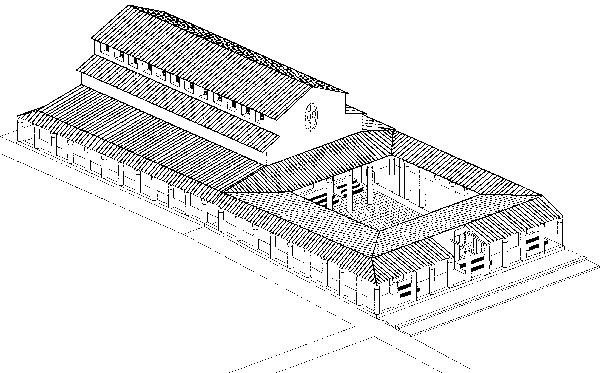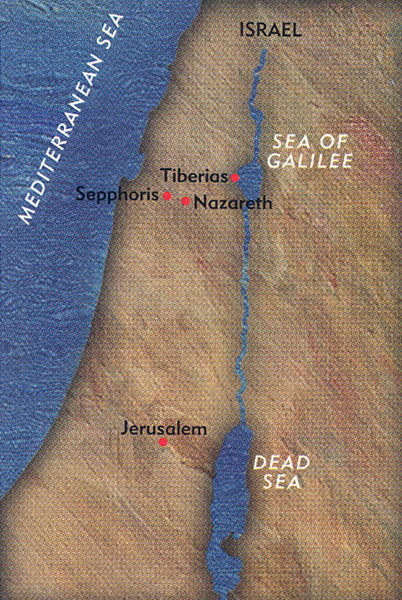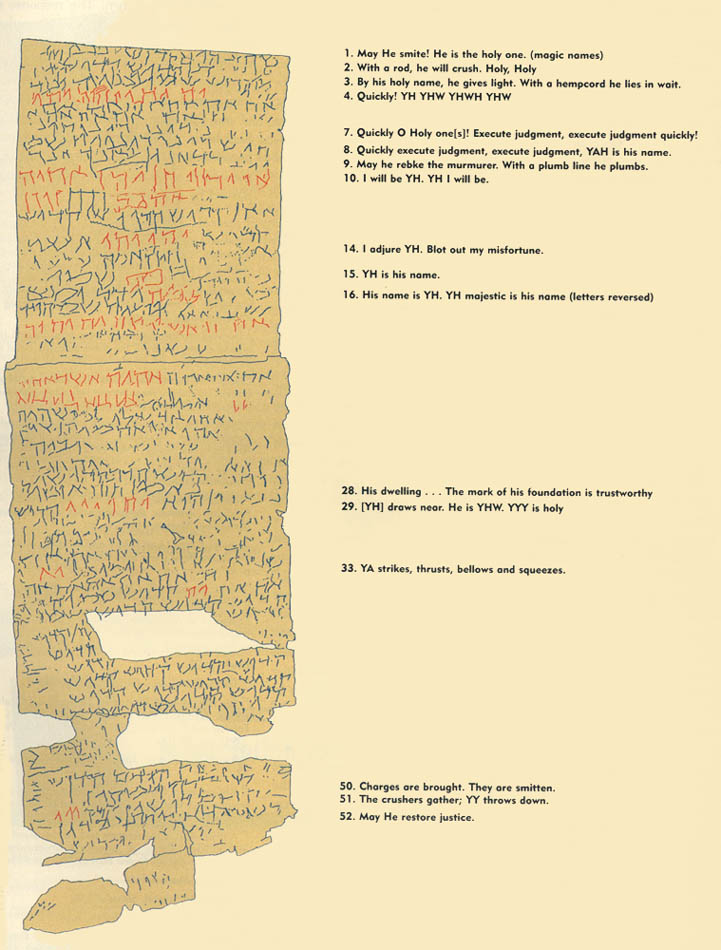In 1992 and 1993, at Sepphoris (in Hebrew, Tzippori) in the lower Galilee, we uncovered two inscribed amulets designed to invoke magical powers.1 It’s not abracadabra; it’s WHYHAW and AWAAA. See if that will cure your fever!
These two amulets, small silver and bronze scrolls, open a fascinating window on life in a mixed Jewish-Christian-Greek city in the late fourth or early fifth century C.E.

Overlooking an ancient trade route between the Mediterranean and the Sea of Galilee, Sepphoris sits on a hill that was probably occupied as early as the Iron Age (beginning about 1200 B.C.E.). The large building in which our amulets were found was constructed in the early first century C.E. It was a typical rectangular basilical building (see drawing, above) with rows of columns enclosing a central open space decorated with pools and paved with mosaics. Around the entire structure was a series of small rooms or shops. A second floor probably housed more shops. By the fourth century the building had been partially destroyed; many of its magnificent stones were cannibalized and used in other structures. The surviving parts of the building were transformed into, among other things, a glass factory and a public bath. Our amulets were found in the part of the building that continued to function as commercial public space.
By the fourth century C.E., Sepphoris already had a long and distinguished history. The first-century C.E. Jewish historian Josephus called the city “the ornament of all Galilee.” Four miles northwest of Nazareth, Sepphoris was a cultured Greco-Roman urban center with a thriving theater and elegant homes decorated with mosaic floors. The Romans of the second century called it Diocaesarea, in honor of Caesar and the chief Roman god, Jupiter. The city also housed a large Jewish population and was the foremost Jewish city in Galilee. It was here that the first great rabbinic text, the Mishnah, was redacted in about 200 C.E. by the revered Judah ha-Nasi, known in Jewish tradition simply as Rabbi. The Jewish high court, the Sanhedrin, sat for a time at Sepphoris in the second and third centuries C.E.
The earliest literary references to a Christian presence in the city can be traced to the mid-fourth century. Since the family of the Virgin Mary was said to have come from Sepphoris, the site became a destination for pilgrims, including the Crusaders, who built a small church there dedicated to St. Anne.
Both of the amulets were found at the same level, about a foot and a half below the surface, along with other artifacts from the late fourth and early fifth centuries. They were both tightly wrapped, and the silver one was still encased in its copper housing.2 When unrolled (the difficult task was accomplished by Joseph “Dodo” Shenhav of the Israel Museum), the texts were easily identified as Palestinian Aramaic (bronze) and Hebrew (silver).
The unrolled bronze amulet (see second sidebar to this article), which has the shorter text (13 lines), is 3 inches long and about 1.3 inches wide. Although the casing of the bronze amulet is missing, the tiny scroll is remarkably well preserved with three of its edges still intact. The text, which was likely incised with a sharp bronze stylus, remains quite legible. Originally, the amulet was probably enclosed in a case, attached to a string and worn around the neck to ward off fever. The first line of the text proclaims that this is “An amulet against fever.”
Many ancient amulets identify the person for whom the amulet was made—for example, a late-sixth-century C.E. copper amulet from Horvat Kanaf is inscribed “a proper amulet to heal Ya’itha.”3 That our amulet does not contain a personal invocation suggests that it was probably mass produced and thus offered at a lower cost. Fevers were by far the most frequent health problem addressed by amulet incantations, and there may have been a large market for such amulets.
Amulet incantations offered protection not only from simple fevers but from “protracted” (rabatah) fevers. Although distinctions among fevers are unusual in Aramaic terminology, they are well established in Greek tradition. Greek medical terminology clearly distinguishes among types of fevers, and Greek amulets readily picked up these words and phrases. For example, several fever amulets written on papyrus differentiate fevers in terms of duration.4 Other Greek magical papyri prescribe different formulas for fevers that occur daily, nightly or, at least in one case, chronically.5 Where Aramaic magical incantations make distinctions among fevers, they are simply borrowing Greek terminology,6 which is what happened at Sepphoris. Indeed, this amulet’s description of the fever as one that “burns” and “does not cease” probably draws on Greek medical lore.
As fever is common, so are magical signs. They appear on the bronze amulet in lines 4, 5, 9, 10 and 11. But what do they mean? These signs appear with remarkable regularity on Greek, Hebrew and Aramaic amulets, magic bowls, lamps and texts after the second century C.E. In Greek magical papyri, they are called charaktêres. In some cases they stand alone, apparently representing some magical or apotropaic power. As one scholar has recently noted, they “were seen as personifying, representing, and embodying great power.”7 But their more precise significance remains a mystery.
A series of letters following the magical signs is also a common feature of amulets. In some cases, the series alludes to divine names or powers; in other examples, called voces mysticae (mystical utterances), the letters are jumbled with no relationship to known words or phrases. But it is unlikely that these unintelligible speech forms are mere gibberish. They are used to communicate with a higher realm that demands a different language, one more elevated and arcane.8 As Clement of Alexandria commented in the second century, “Plato assigns a special discourse to the gods and he reaches this conclusion from the experience of dreams and oracles but most of all from those possessed by daimones, for they do not speak their own language or discourse but rather the language of the daimones who possess them.”9
The first series of letters incised on the bronze amulet, NNN, in line 5, has no known meaning; nor is this a common set of letters for Aramaic amulets. The next series, WHYH (Wah Yah), also in line 5, may represent the divine name Yahweh. Such a rendering occurs on other Aramaic amulets and in texts from the Cairo Genizah.a A third series of letters is also difficult to decipher. A possible reading is AW, AAA, SSS. If AW is some sort of contraction of the divine name, the series of alephs and sins could then be an elaboration on the root of fever (AS). This reading could, in part, invoke the divine name in association with fever or fire (the same word). The power of God would then be brought to bear on the fever.
Our silver amulet (see last sidebar to this article) is about 4.3 inches long and a bit more than 1 inch wide. Although it is approximately the same size as the bronze amulet, its text is much longer. Compared to 13 lines on the bronze amulet, 55 lines are crammed onto the silver amulet. At some points the scribe even wrote sideways in the small margin. This amulet was incised not as protection but to provide a magical chant that solicits sacred power to manipulate someone or some situation to the benefit of the amulet’s owner. Such incantations might have been used punitively against one of the owner’s enemies—to make him ill, to bring him bad luck at the race track, or to cause him to stumble in an athletic competition—or to force someone to comply with the owner’s will.
Other inscriptions seek to persuade a loved one to return the amulet wearer’s affection. An incised potsherd from Horvat Rimmon, near Beer-Sheva, implores the sacred powers to inflame the heart of the beloved: “You ho[ly (and mighty)] angels, I adjure you, just as [this sherd burns, so shall] burn the heart of R[ son/daughter of Mar]ian after me.”10
This small silver amulet contains a curse text. Curse texts, common at this time, call upon demons or gods to render harm to some competitor or enemy for reasons that remain unspecified. A third-century C.E. lead tablet discovered at Carthage, in north Africa, calls upon the gods to disable a chariot driver and his horses at a competition in the city’s hippodrome: “A curse, I invoke you [plural] by the great names so that you will bind every limb and every sinew of Victoricus—the charioteer of the Blue team, to whom the earth, mother of every living thing, gave birth—and of his horses which he is about to race.”11
The silver amulet’s text is an appeal for revenge or judgment. The lines selected for translation in the last sidebar to this article give the impression of a more coherent text than is actually the case. In the complete text, appeals for action against the antagonist(s) are often followed by several lines of repeated forms of the divine name or the word “holy,” as if offering a chant.
We can characterize the silver amulet more narrowly as what has been called a “judicial prayer.”12 This category appears to be applicable because God or God’s agents, identified by several names and epitaphs, are invoked by various formulas in order to render justice. YAH, YH, YHW and perhaps even YYY and YY are all theophoric elements,b which are used here to call on the “holy, holy” name of Yahweh, the personal name of the Israelite God, to rectify a perceived injustice (see the first sidebar to this article). The wrong suffered by the owner of the silver scroll amulet, however, is described only vaguely as “my misfortune.”

As biblical texts are often woven into magical formulas, we should not be surprised to find biblical resonances appearing on this amulet. For example, line 9 asks for a “rebuke” (yig’ar).13 In a vision the biblical prophet Zechariah sees the Lord rebuking Satan (Zechariah 3:2). Line 9 of our silver amulet also contains the phrase “with a plumb line, he plumbs.” In the Bible, the prophet Amos reports a vision in which Yahweh uses the image of the plumb line metaphorically to describe the Israelites as “warped” beyond correction; thus their sanctuaries and ruling house are to be destroyed (Amos 7:7–9).14
But who are the bad guys referred to on the silver amulet? The offending parties are as obscure as the wrong committed; they are identified only as “murmurers” (the meaning of which is unclear) or “oppressors.” One possibility is that the enemy is the malignant spirit (as is often the case with disease) that has caused the misfortune and needs to be flushed out and destroyed.
Another possibility relates to the social situation in Sepphoris, which in the late fourth and early fifth centuries was a city in transition. In the mid-fourth century, the city suffered two heavy blows. The so-called Gallus Revolt (against Gallus Caesar) broke out in Sepphoris in 351 C.E. It was quelled by the Roman commander—how much destruction occurred is not yet clear, though as noted earlier, the building in which the amulets were found appears to have been badly damaged. Then in 363 the city suffered a major earthquake.
By the fifth century, Christians were aggressively attempting to Christianize Sepphoris. Conflict between Jews and Christians (now separated from their Jewish origins) was rife throughout Byzantine Palestine. In one case, the monk Bar Sauma and his roving band of monks attempted to destroy synagogues throughout Palestine. The Talmud refers specifically to conflicts in Sepphoris between rabbinic authorities and minim, or heretics. The term min seems to stand for religious practices or beliefs, including those associated with Jewish Christians, that were opposed by the rabbis.15 Perhaps the “murmurers” referred to in the amulet are Christians or Jews who had succumbed to Christianization.
Most amulets recovered from the soil of ancient Galilee date between the late fourth century and the sixth century C.E., as do our bronze and silver scrolls. The amulets from this period weave together biblical epithets for God in Aramaic and Hebrew, allusions to the Bible, and phrases and symbols drawn from the wider sphere of Greco-Roman magical practice. They clearly represent a departure from official religion, both Jewish and Christian.
But these deviations, which are reflections of popular religion, were so widespread that religious authorities tried to exercise some control over them, even though they could not eradicate them altogether. In an early rabbinic text, for example, there is a discussion as to what qualifies as an “expert” amulet. Not surprisingly, an expert amulet is defined as one that was issued by an expert or that had cured ailments on three occasions.16 Another rabbinic text distinguishes between curative and prophylactic amulets and discusses whether the Torah (the scroll containing the five books of Moses) may be used to cure a disease. The rabbis decided that the Torah may be used on those amulets intended to protect against disease but not on those used to cure a disease.17
The leaders of the early Christian community tended to be less conciliatory toward any use of magic or magical implements. This intransigence may have been, in part, a consequence of the Jewish character of much of the magical language. Time and again, Christian authors berate their followers for “going to the Jews” for healing and magical charms. Some Christian authors illustrate Christian influence over Jews with macabre stories of contests involving magical powers. Socrates, the fifth-century C.E. church historian, tells of a man whom magicians tried to free from demonic possession: “Neither the pagans nor the Jews could by any incantations and enchantments, deliver him from his affliction Hilarion by simply calling on the name of Christ, expelled the demon and Alaphion, with his whole family, immediately embraced Christianity.”18
Epiphanius of Salamis tells a similar story about Joseph of Tiberias, a Jew by birth, who eventually gained permission to build a church in Sepphoris. Joseph secretly observed a man named Judah using magical rites and implements to attract the interest of a young Christian woman. Judah had “been led astray” by other young men and had become known for his “many evil acts,” including “debauchery of women and unholy sex.” When Judah encountered the Christian woman at the baths, he “rubbed his side against her” but she rebuffed him; to protect herself from his advances, she then “signed [or crossed] herself in the name of Christ.” This prompted poor Judah to turn to magic in an attempt to gain the woman’s affections. The magic failed because, according to Epiphanius, “the power of sorcery does not prevail where the name of Christ and the sign of the cross are.” This display of the countervailing power of Christian “magic”—along with other, less salacious events—convinced Joseph to convert to Christianity.19 The fifth-century C.E. rabbi Isaac of Antioch composed a series of homilies against the Jews in which he chastised Christians for using amulets bearing Jewish symbols—apparently religious authorities felt that each group should keep its own traditions.20
The line between magic and religion was not sharply drawn. The response of religious authorities to the use of amulets may be best characterized as grudging acceptance combined with eager efforts toward exercising some control over how they were to be employed. The recovery of our silver and bronze amulets from Sepphoris is a reminder that religious practice and the use of sacred language goes on in a wider circle than is encompassed by sanctioned texts.
MLA Citation
Footnotes
According to Jewish law, worn-out documents bearing the name of God cannot be destroyed; instead, they are stored in a genizah prior to burial. The Cairo Genizah was the genizah of the Ben Ezra Synagogue, built in the 11th century C.E. in old Cairo (Fostat).
Endnotes
Recent archaeological excavations have been conducted at Sepphoris by teams from the University of South Florida, Duke University, Hebrew University in Jerusalem and Tel Aviv University. The amulets discussed in this article were found by the team from the University of South Florida, under the direction of Professor James F. Strange.
The copper case appears to have been incised (not an uncommon practice), but these incisions could not be deciphered.
Joseph Naveh and Shaul Shaked, Amulets and Magic Bowls: Aramaic Incantations of Late Antiquity (Jerusalem: Magnes, 1987), p. 45.
Robert Daniel and Franco Maltomini, eds., Supplementum Magicum, 2 vols. (Oplanden: Westdeutscher Verlag, 1990–1992), pp. 47–48, 1.27.
Joseph Naveh and Shaul Shaked, Magic Spells and Formulae: Aramaic Incantations of Late Antiquity (Jerusalem: Magnes, 1993), p. 60.
John G. Gager, Curse Tablets and Binding Spells from the Ancient World (New York: Oxford Univ. Press, 1992), p. 11.
See H.S. Versnel, “Beyond Cursing: The Appeal to Justice in Judicial Prayer,” in Magica Hiera, ed. C.A. Faraone and D. Obbink (New York: Oxford Univ. Press, 1991), pp. 60–106.
We are aware that the text of Amos 7:7–8 is problematic and that this translation is not universally accepted.
A discussion of the relevant text can be found in S. Miller, “The Minim of Sepphoris Reconsidered,” Harvard Theological Review 86:4 (1993), pp. 377–402.
Philip R. Amidon, S.J., trans. and ed., The Panarion of St. Epiphanius, Bishop of Salamis (New York: Oxford Univ. Press, 1990), 30.7–8.





